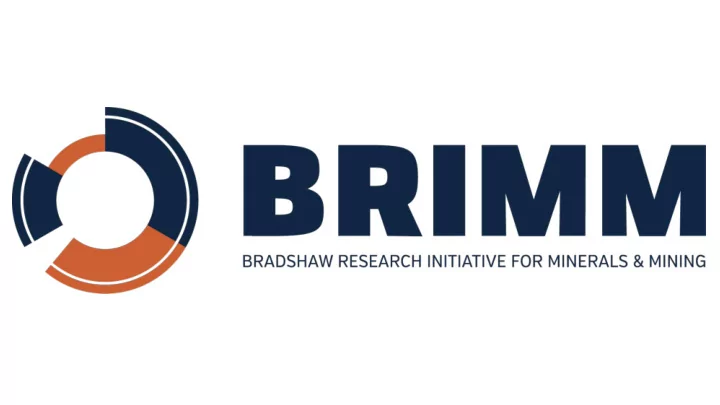

BRIMM: Is a collaboration between world-class scientists and engineers to advance cross-disciplinary research encompassing the entire life-cycle of mining, from exploration to extraction, from processing to rehabilitation. Adopts a “minerals first” approach that embraces the complexity of geological deposits, to improve knowledge, enhance efficiency and manage risk from exploration right through to closure and remediation.
BRIMM: Will drive data integration across the traditional silos of exploration, mining and environmental impact to produce to a greater appreciation of ore diversity for processing and waste management while maximizing the value of information collected at each stage of the mining cycle.
BRIMM GOALS 1. Expand capacity and visibility of UBC mining-related research on-campus and downtown 2. Foster collaboration and engage new UBC research expertise 3. Engage with the minerals industry to identify new and relevant areas of multi-disciplinary research
BRIMM GOALS 4. Motivate and provide seed funding to new integrated and multi-disciplinary research across the full mine cycle in projects that attract direct industry financial support 5. Provide advanced training across mineral systems and the mining life cycle 6. Increase mining-related research capacity at UBC
UBC Expertise: Faculty
UBC Expertise: Area of Application
UBC Expertise: Affiliations
UBC Expertise: Research Tools
BRIMM RESEARCH THEMES The Mining Microbiome • Develop biomarkers for exploration • Engineer new bioprocesses for mineral extraction, metal recovery, waste stabilization and effluent treatment • Develop biomarkers for environmental and risk assessment • Maximize the effectiveness of ecological restoration
BRIMM RESEARCH THEMES The Mining Microbiome 100 Species Other Otu1_Tissierella • Bacteria are among the best geochemists in 75 Otu15_Lysinibacillus Otu16_Pseudomonas the world, and occupy niche environments. Percentage Otu17_Exiguobacterium Otu18_Thauera 50 ‘Omics-based detectors of specific genes Otu2_Tissierella Otu3_Clostridium_XI can be used as exploration tools. Otu30_Stenotrophomonas 25 Otu4_Tissierella Otu5_Tissierella • Consortia of particular bacteria can remove Otu6_Tissierella 0 multiple constituents of concern from mine- SeRB Run6 Run8 Enrichment Archaea Bacteria Protobacteria influenced water simultaneously. 60 • Mineral-binding peptides that discriminate Taxon Methanobacteriales Methanomicrobiales between chalcopyrite and enargite can Methanosarcinales Other_Archaea 40 Bacteroidales selectively recover these minerals. Percentage Sphingobacteriales Clostridiales Spirochaetales • Bacteria can remove metals from water in Caulobacterales Rhizobiales Burkholderiales 20 remote mines located in cold climes. Desulfobacterales Desulfovibrionales Xanthomonadales • Microbial communities are resilient and 0 resist catastrophic disturbances making September2008 August2008 October2008 November2008 January2009 February2009 March2009 April2009 May2009 June2009 July2009 September2008 August2008 October2008 November2008 January2009 February2009 March2009 April2009 May2009 June2009 July2009 September2008 August2008 October2008 November2008 January2009 February2009 March2009 April2009 May2009 June2009 July2009 ecological recovery possible. Month
BRIMM RESEARCH THEMES The Mining Microbiome • Steven Hallam • Shaun Crowe • Bill Mohn • Susan Baldwin • Vikram Yadev • Scott Dunbar • Marcello Veiga • Uli Mayer • Roger Beckie • Suzanne Simard • Shaun Mansfield • Sue Grayston • Cindy Prescott • Steve Withers
BRIMM RESEARCH THEMES CT scan of a flocculated sediment Geometallurgy • Integrate geological, mining, metallurgical, environmental and economic data to create an accurate spatial and geologically- based orebody model to maximize value while minimizing risk throughout the mining value chain. • Combine information from exploration, extraction, processing, and waste management to better understand key performance Distribution of solids contents in a cross- issues such as, energy consumption, grade, grindability, section (slice) of a CT-scanned sediment efficiency of separation, water retention and tailings reactivity. • New approaches to core logging are needed to allow data collected to be systematic and spatial. This requires the innovative use of tools and development of geometallurgy- specific logging methods. • Enable innovation and development of new approaches to handling, treating, and storing tailings and leaching residues that extracts maximum value from gangue heterogeneity and maximizes water recovery.
BRIMM RESEARCH THEMES Geometallurgy Exploration geochemical data is available deposit wide. Use of these date to estimate mineral abundance allows: • Ore and gangue heterogeneity to be assessed • Representative samples to be more easily identified so they can better inform metallurgical testing Sufficient Labile Mg • Assessment of environmental reactivity of tailings as a for GHG offsets function of alteration style and ore type Three-dimensional model of brucite abundance in the Decar Ni Deposit Brucite adundance Labile magnesium content of tailings by ore tonnage. Labile Mg represents an economical pathway to carbon sequestration in tailings and potential offsets to GHG emissions to reduce carbon tax and improve environmental impact.
BRIMM RESEARCH THEMES Geometallurgy: People • Dirk van Zyl • Uli Mayer • Craig Hart • Sue Baldwin • Greg Dipple • David Dreisinger • Ed Asselin • Bern Klein • Marek Pawlik • Maria Holuszko • Sanja Miskovic • Ilja Miskovic • Marcello Veiga • Ali Madiseh • Davide Elmo
PDAC 2019 UBC Reception UBC Science faculties, BRIMM, NBK, MDRU, invite you to join us for an exclusive gathering during the PDAC conference in Toronto. This is your opportunity to expand your network, discuss industry trends and hear the latest about UBC. Tuesday, March 5th 2019, 5:30pm – 8:00pm The Fairmont Royal York 100 Front Street West, Toronto Info: info@brimm.ubc.ca
Recommend
More recommend